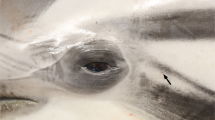Summary
A quick method was developed for isolating the stimulus-receiving apparatus (stereovilli=‘stereocilia’) from the vestibular apparatus of fish (Scardinius erythrophthalmus andRutilus rutilus) in sufficient quantity and purity to study the solubilities and stabilities of their structural elements by electron microscopy. The stereovilli were adsorbed to a support and, after various treatments, negatively stained or metal shadowed after freeze drying. For comparison, and in order to ensure the validity of the method, some experiments were similarly performed on intestinal microvilli from chicken. Microvilli adsorbed to a support gave similar results as in suspension. Stereovilli and microvilli are similar in their architecture, except for the specialized base of stereovilli, and in the Mg2+- or Ca2+-induced splaying of the actin cores. Major differences occur in the solubilities of the linkers which connect the actin core and the membrane (a-m-linkers). In contrast to microvilli, these linkers are removed from the stereovilli core together with the membrane by Triton-X-100. The linkers together with some membrane components are preserved by glutaraldehyde fixation prior to detergent extraction. In stereovilli, the position of the linkers is recognizable in fixed material. In microvilli the membrane contains so much material, which becomes detergent insoluble after glutaraldehyde fixation, that the linkers become completely obscured.
Similar content being viewed by others
References
Bretscher, A. (1981a) Characterization and ultrastructural role of the major components of the intestinal microvillus cytoskeleton. InCold Spring Harbor Symposia on Quantitative Biology, Vol. 46, part II, pp. 871–9.
Bretscher, A. (1981b) Fimbrin is a cytoskeletal protein that crosslinks F-actinin vitro.Proceedings of the National Academy of Science USA 78, 6849–59.
Bretscher, A. &Weber, K. (1978) Purification of microvilli and an analysis of the protein components of the microfilament core bundle.Experimental Cell Research 116, 397–407.
Bretscher, A. &Weber, K. (1980) Villin is a major protein of the microvillus cytoskeleton which binds both G and F actin in a calcium dependent manner.Cell 20, 839–47.
Flock, A. &Cheung, H. C. (1977) Actin filaments in sensory hairs of inner ear receptor cells.Journal of Cell Biology 75, 339–43.
Flock, A., Flock, B. &Murray, E. (1977) Studies on sensory hairs of receptor cells in the inner ear.Acta oto-laryrngologica 83, 85–91.
Flock, A., Bretscher, A. &Weber, K. (1982) Immunohistochemical localization of several cytoskeletal proteins in the inner ear sensory and supporting cells.Hearing Research 6, 75–89.
Glenney, Jr, J. R., Kaulfus, P., Matsudaira, P. &Weber, K. (1981) F-actin binding and bundling properties of fimbrin, a major cytoskeletal protein of microvillus core filaments.Journal of Biological Chemistry 256, 9283–8.
Helenius, A. &Simons, K. (1975) Solubilization of membranes by detergents.Biochimica et Biophysica Acta 415, 29–79.
Hirokawa, N. &Heuser, J. E. (1981) Quick-freeze, deep-etch visualization of the cytoskeleton beneath surface differentiations of intestinal epithelial cells.Journal of Cell Biology 91, 399–409.
Hirokawa, N. &Tilney, L. G. (1982) Interactions between actin filaments and between actin filaments and membranes in quick-frozen and deeply etched hair cells of the chick ear.Journal of Cell Biology 95, 249–61.
Hudspeth, A. J. (1983) Mechanoelectrical transduction by hair cells in the acousticolateralis sensory system.Annual Review of Neurosdence 6, 187–215.
Howe, C. L., Mooseker, M. S. &Graves, T. A. (1980) Brush-border calmodulin.Journal of Cell Biology 85, 916–23.
Jahnke, K. (1975) The fine structure of freeze-fractured intercellular junctions in the guinea pig inner ear.Acta oto-laryngologica suppl. 336, 5–40.
Lowenstein, O. E. (1974) Comparative morphology and physiology. InHandbook of Sensory Physiology VI/1, Vestibular System, Part 1,Basic Mechanisms (edited byKornhuber, H. H.), pp. 75–120. Berlin, Heidelberg, New York: Springer.
Matsudaira, P. T. &Burgess, D. R. (1979) Identification and organization of the components in the isolated microvillus cytoskeleton.Journal of Cell Biology 83, 667–73.
Matsudaira, P. T. &Burgess, D. R. (1982) Organization of the cross-filaments in intestinal microvilli.Journal of Cell Biology 92, 657–64.
Mooseker, M. S. &Tilney, L. G. (1975) Organization of an actin filament membrane complex. Filament polarity and membrane attachment in the microvilli of intestinal cells.Journal of Cell Biology 67, 725–43.
Mukherjee, T. &Staehelin, L. A. (1971) The fine structural organization of the brush border of intestinal epithelial cells.Journal of Cell Science 8, 573–99.
Pscheidt, P., Schudt, C. &Plattner, H. (1981) Cryofixation of monolayer cell cultures for freeze-fracturing without chemical pretreatment.Journal of Microscopy 121, 149–67.
Schmidt, B. (1983)Reizaufnehmende Strukturen in mechanorezeptiven Haarsinneszellen des Frosch-Sacculus. Diplomarbeit, Fachbereich Biologie, Universität Münster.
Thurm, U. (1981) Mechano-electric transduction.Biophysics of Structure and Mechanism 7, 245–6.
Tilney, L. G., Derosier, D. J. &Mulroy, M. J. (1980) The organization of actin filaments in the stereocilia of cochlear hair cells.Journal of Cell Biology 86, 244–59.
Tilney, L. G., Egelmann, E. H., Derosier, D. J. &Saunders, J. C. (1983) Actin filaments, stereocilia, and hair cells of the bird cochlea. II. Packing of actin filaments in the stereocilia and in the cuticular plate and what happens to the organization when the stereocilia are bent.Journal of Cell Biology 96, 822–34.
Weber, K. &Glenney, Jr, J. R. (1981) Calcium-modulated multifunctional proteins regulating F-actin organization. InCold Spring Harbor Symposia on Quantitative Biology, Vol. 46, Part I, pp. 541–52.
Wersäll, J. &Bagger-Sjöbäck, D. (1974) Morphology of the vestibular sense organ. InHandbook of Sensory Physiology VI/I, Vestibular System, Part 1,Basic Mechanisms (edited byKornhuber, H. H.), pp. 123–84. Berlin, Heidelberg, New York: Springer.
Zingsheim, H. P., Abermann, R. &Bachmann, L. (1970) Apparatus for ultrashadowing of freeze-etched electron microscopic specimens.Journal of Physics, E.: Science Instruments 3, 39–42.
Author information
Authors and Affiliations
Rights and permissions
About this article
Cite this article
Neugebauer, DC., Thurm, U. Chemical dissection of stereovilli from fish inner ear reveals differences from intestinal microvilli. J Neurocytol 13, 797–808 (1984). https://doi.org/10.1007/BF01148494
Received:
Revised:
Accepted:
Issue Date:
DOI: https://doi.org/10.1007/BF01148494



